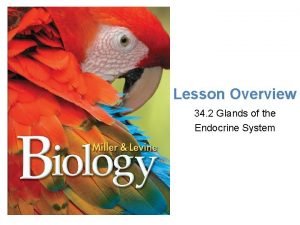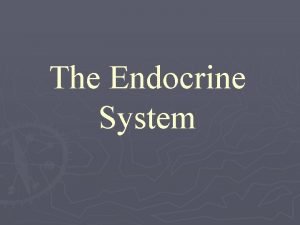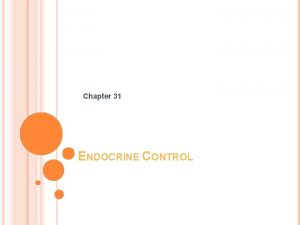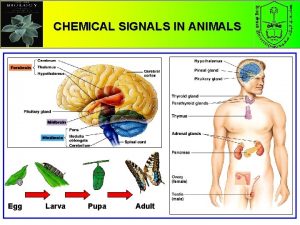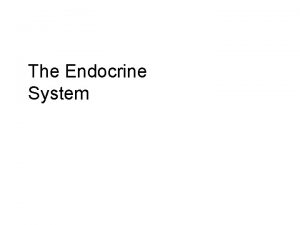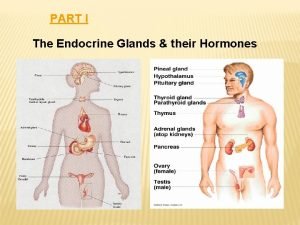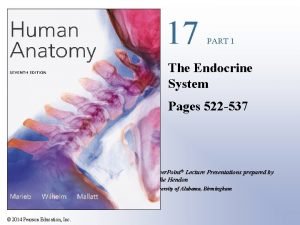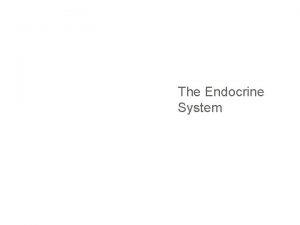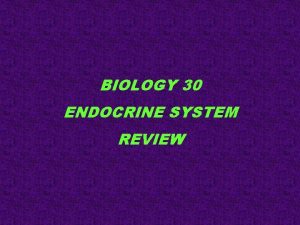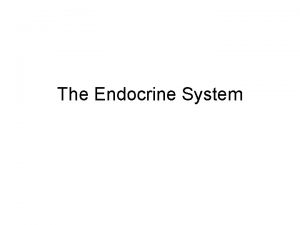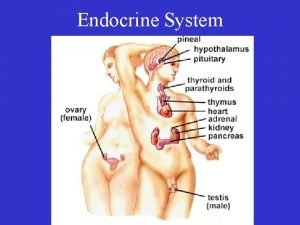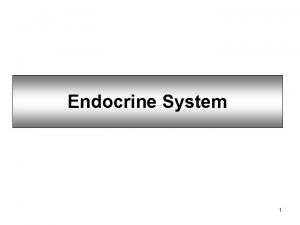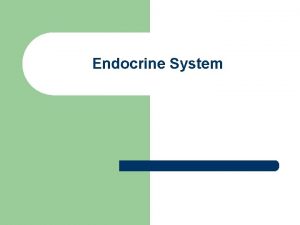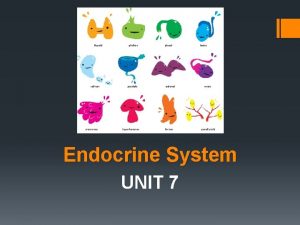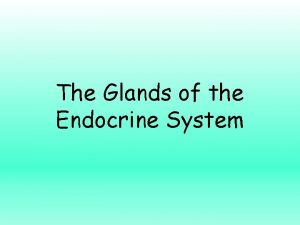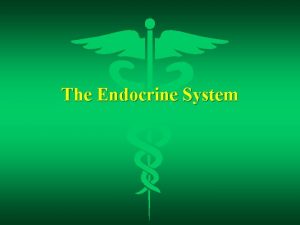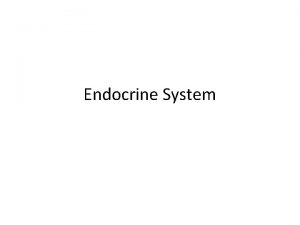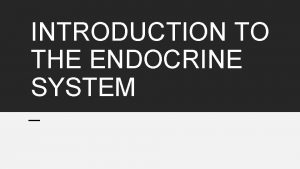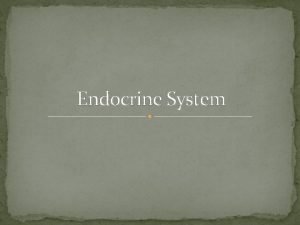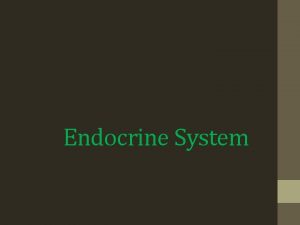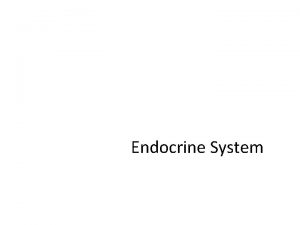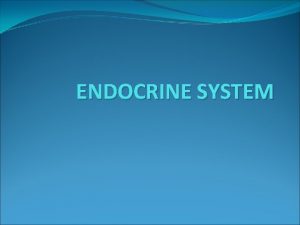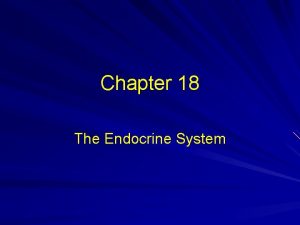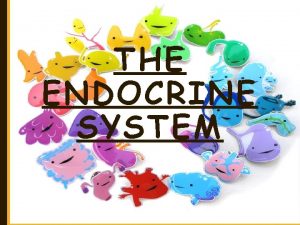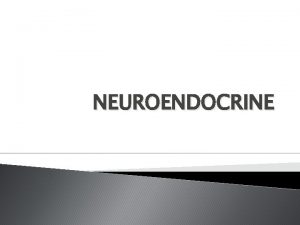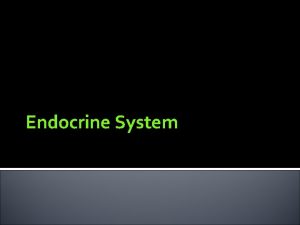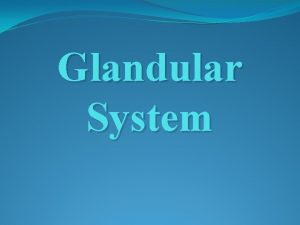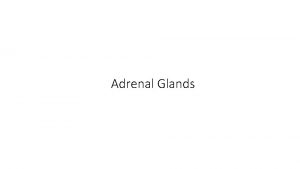The Glands of the Endocrine System Endocrine Glands






























- Slides: 30

The Glands of the Endocrine System

Endocrine Glands • Hypothalamus • Pituitary – Anterior – Posterior • Thyroid Gland • Parathyroid glands • Adrenal Glands – Cortex – Medulla • Pancreas – Islets of Langerhans • Gonads – Ovaries or – Testes • Pineal gland • Thymus

Hypothalamus • Part of brain – Regulates ANS, sex drive, hunger, thirst, body temperature, etc. – Hormones related to these functions • “Releasing hormones” • Axonal transport to posterior lobe

Anterior Pituitary – TSH (thryoid stimulating hormone) – ACTH (adrenocorticotropic hormone) – – FSH (gonadotropin) LH (gonadotropin) GH (growth hormone) Prolactin-releasing hormone

Anterior Pituitary Imbalances Growth hormone (GH or h. GH) – Promotes mitosis, cell division – Elongation of long bones, etc. – Healing of wounds, lack of h. GH slows growth – Hypersecretion in childhood results in giantism – Hyposecretion in childhood results in dwarfism – Hypersecretion in adult produces acromegaly

Pituitary—Posterior lobe • Oxytocin – Stimulates smooth muscle contraction of uterus & mammary glands, feels of attachment. • ADH – Stimulates water reabsorption in collecting ducts. – Stimulates vasoconstriction (vasopressin) – Lack diabetes insipidus

Posterior Pituitary Imbalances ADH – Hyposecretion produces diabetes insipidus “tasteless” – Excessive thirst and urination Diabetes Insipidus Foundation, Inc.


Thyroid Gland • Located in neck • Composed of follicles that produce: • Thyroxin (T 4) • Triiodothyronine (T 3) – Both “thyroid hormones”, are the body’s major metabolic hormone • Parafollicular cells produce: • Calcitonin – Decreases blood Ca 2+ by depositing it in bones

Thyroid imbalances • Hypothyroidism results in: – Myxedema – Goiter - low levels of iodine – Cretinism • Hyperthyroidism results in: – Graves disease

Parathyroid Glands • Four small glands embedded in posterior of thyroid – Parathyroid hormone (PTH) – Stimulates osteoclasts to release Ca 2+ from bone – Stimulates Ca 2+ uptake from intestine & kidney

Parathyroid Imbalances • Severe hyperparathyroidism causes massive bone destruction • If blood Ca 2+ fall too low, neurons become overactive, resulting in tetany

Adrenal Glands Located on top of each kidney • Cortex – Corticosteroids • Medulla • Epinephrine • Norepinephrine

Adrenal Cortex • Cortex – Mineral corticoids • Aldosterone regulate salt and water balance – Glucocorticoids • Cortisol regulate glucose metabolism and the immune . – Gonadocorticoids system • Androgens • Estrogens

Adrenal Cortex Imbalances • Hypersecretion leads to Cushing’s disease • Hyposecretion leads to Addison’s Disease

Adrenal Medulla • Medulla – The adrenal medulla mediates short–term responses. – Cells are modified neurons (lack axons) • Epinephrine (adrenaline) • Norepinephrine (noreadrenaline) – enable a rapid ( fight-orflight ) response to stress by increasing blood glucose and blood pressure and directing blood to the heart, brain and skeletal muscles.

Pancreas • Consists of two major types of secretory tissues which reflects its dual function – Exocrine gland • secretes digestive juice • localized in the acinar cells – Endocrine gland • releases hormones • localized in the islet cells (islets of Langerhans)

Pancreatic Islets • Approximately a million within the pancreas • Control centers for blood glucose – Insulin from beta cells – Glucagon from alpha cells

Pancreas Imbalances Diabetes Mellitus

Gonads • Ovaries – Estrogen – Progesterone • Testes – Testosterone • Reproductive functions when we study reproductive system.

Pineal gland • Melatonin – Day/night cycles • Timing of sleep, body temperature, appetite • Secretion of melatonin begins with darkness – Participates in setting the body’s clock • Melatonin is a potent antioxidant • Melatonin is high when young and is reduced as we age

Thymus • Thymopoietins, thymic factor, thymosins – Influence development of T lymphocytes

Non-Endocrine Gland Hormones • Stomach (gastrin) • Small intestine (duodenum intestinal gastrin, secretin, cholecystokinin) • Heart (atrial natriuretic peptide) • Kidneys (erythropoietin, active vitamin D 3) • Adipose tissue (leptid, resistin, estrogenlike prostaglandins) • Placenta (human chorionic gonadotropin (h. CG), human placental lactogen, relaxin)

Functions regulated by the Endocrine System • • Growth & Development Healing Water balance Blood Pressure Calcium Metabolism Energy Metabolism Stress Responses Secondary Sex Characteristics

Growth Hormones • Growth hormone-releasing hormone • Human growth hormone (h. GH) • Thyrotropin (TSH) • Thyroxine & triiodothyronine • Calcitonin • Somatostatin (GHIH)

Healing Hormones • Growth hormone-releasing hormone • Human growth hormone (h. GH) • Thyrotropin (TSH) • Thyroxine & triiodothyronine • Calcitonin • Glucagon, Insulin • Erythropoietin

Water Balance & Blood Pressure Hormones • • • ADH Aldosterone Angiotensin II Atrial natriuretic Hormone Epinephrine

Calcium Metabolism Hormones • Calcitonin • Parathyroid Hormone (PTH) • Estrogens/androgens • Growth hormone

Energy Metabolism Hormones • Thyroxine & triiodothyronine • Thyroid-stimulating H. (thyrotropin, TSH) • Epinephrine & norepinephrine • Insulin • Glucagon • Adrenocorticotropic Hormone (ACTH) • Cortisol

Stress Hormones • • Epinephrine & norepinephrine T 4 &T 3 ACTH Cortisol
 Endocrine glands
Endocrine glands Mucous acini
Mucous acini Major endocrine glands male and female
Major endocrine glands male and female Endocrine system organs
Endocrine system organs Difference between endocrine and exocrine glands
Difference between endocrine and exocrine glands Exocrine glands are ductless
Exocrine glands are ductless Pathology
Pathology Whats the difference between endocrine and exocrine glands
Whats the difference between endocrine and exocrine glands Hypothal
Hypothal Endocrine glands
Endocrine glands Endocrine glands secrete
Endocrine glands secrete Endocrine glands
Endocrine glands Hyophysis
Hyophysis Rat urinary system
Rat urinary system Endocrine system and reproductive system
Endocrine system and reproductive system Endocrine system and nervous system
Endocrine system and nervous system Lymphatic system vs endocrine system
Lymphatic system vs endocrine system Nervous system vs endocrine system venn diagram
Nervous system vs endocrine system venn diagram Endocrine system
Endocrine system Cutaneous membrane
Cutaneous membrane Adenohypophysis
Adenohypophysis Module 10 the nervous and endocrine systems
Module 10 the nervous and endocrine systems Comparison of endocrine and nervous system
Comparison of endocrine and nervous system Steroids endocrine system
Steroids endocrine system Facts about the endocrine system
Facts about the endocrine system Calcitonin and pth are antagonistic hormones
Calcitonin and pth are antagonistic hormones Endocrine system pearson
Endocrine system pearson 7:13 endocrine system
7:13 endocrine system Stimulus endocrine system
Stimulus endocrine system Stimulus humoral
Stimulus humoral Biology 30 endocrine system
Biology 30 endocrine system
